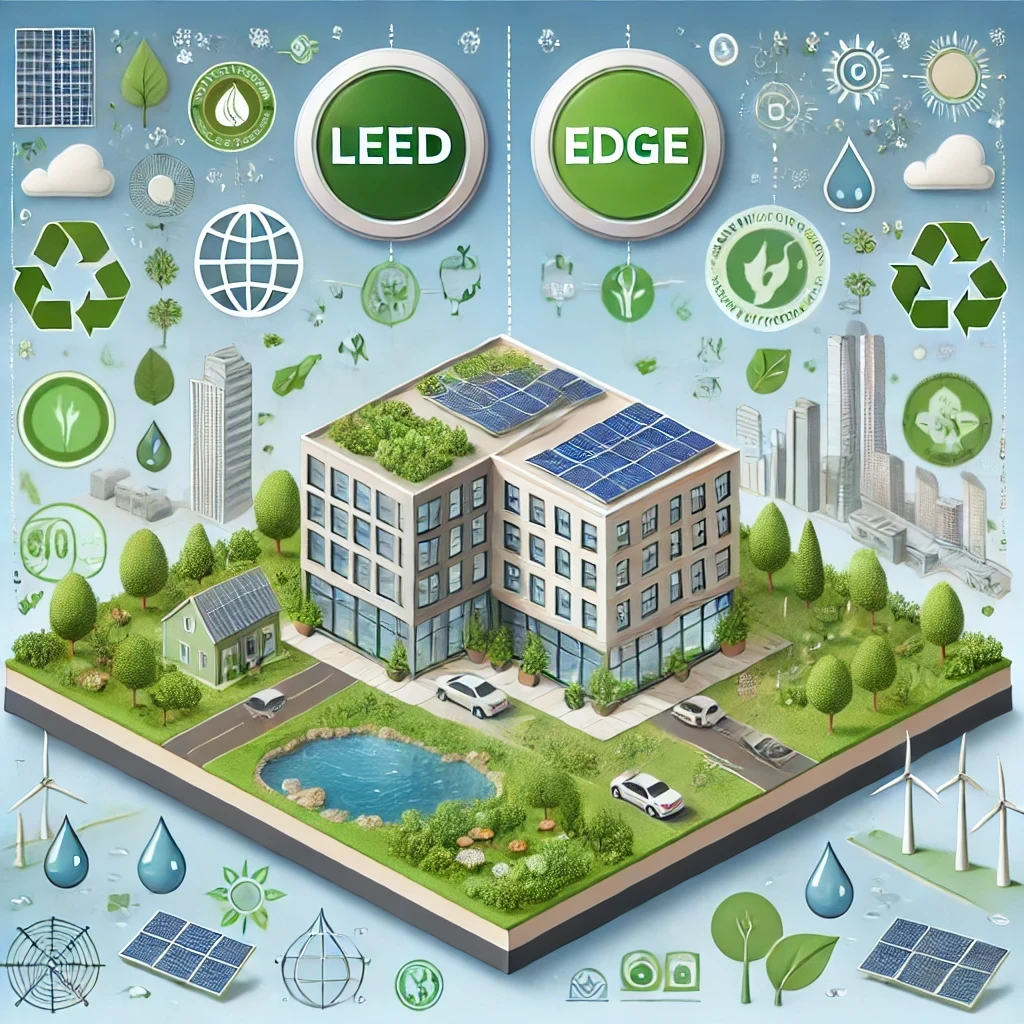As sustainability becomes a priority in the built environment, green building certifications have gained widespread adoption. Among the most recognized certification systems are LEED (Leadership in Energy and Environmental Design) and EDGE (Excellence in Design for Greater Efficiencies). While both aim to promote sustainable construction and reduce environmental impact, they differ in their approach, focus areas, and target audience. Understanding these differences can help project teams select the most suitable certification for their sustainability goals.
What is LEED Certification?
LEED, developed by the U.S. Green Building Council (USGBC), is a globally recognized green building rating system that evaluates sustainability across various aspects of design, construction, and operation. It applies to new buildings, existing structures, homes, and even entire neighborhoods.
Key Features of LEED:
Comprehensive Approach: Assesses sustainability across energy efficiency, water conservation, materials, indoor air quality, and site sustainability.
Point-Based System: Projects earn points in different categories, with certification levels ranging from Certified to Platinum.
Encourages Innovation: Rewards projects implementing advanced sustainability strategies through innovation and regional priority credits.
Diverse Rating Systems: LEED offers BD+C, ID+C, and O+M, catering to various building types.
Performance Tracking: Certified buildings are encouraged to monitor and improve performance using tools like Arc Skoru.
What is EDGE Certification?
EDGE, developed by the International Finance Corporation (IFC) (a World Bank Group member), is a simplified and cost-effective green building certification designed primarily for emerging markets. It focuses on resource efficiency, making it ideal for affordable housing, commercial buildings, and hotels.
Key Features of EDGE:
Efficiency-Driven: Prioritizes energy efficiency, water conservation, and embodied energy in materials.
Baseline 25% Reduction: Buildings must demonstrate at least a 20-25% reduction in energy, water, and material impact compared to conventional buildings.
User-Friendly Digital Tool: The EDGE App helps project teams evaluate sustainability measures in real time.
Lower Cost, Faster Certification: EDGE is designed to be a budget-friendly and time-efficient certification.
Ideal for Developing Regions: Popular for affordable housing, retail, hospitals, and office buildings in emerging markets.
Key Differences Between LEED and EDGE
| Feature | LEED Certification | EDGE Certification |
|---|---|---|
| Developed By | USGBC | IFC (World Bank Group) |
| Scope | Holistic sustainability | Efficiency-focused (energy, water, materials) |
| Certification Levels | Certified, Silver, Gold, Platinum | Single-level certification (min. 25% efficiency) |
| Primary Focus | Comprehensive environmental impact | Resource efficiency in emerging markets |
| Assessment Criteria | Energy, water, materials, air quality, site selection, innovation | Energy, water, and embodied energy in materials |
| Cost & Time | Higher cost, longer process | Lower cost, faster approval |
| Target Audience | Large-scale commercial, institutional, and residential projects | Mid-sized commercial buildings, housing, and hotels |
| Software Tool | LEED Online & Arc for tracking | EDGE App for real-time sustainability analysis |
| Global Adoption | Widely used worldwide | Growing in emerging markets |
Which Certification Should You Choose?
Selecting LEED or EDGE depends on your project’s goals, budget, and location:
Choose LEED if:
You need a comprehensive sustainability framework.
Your project is a large commercial, institutional, or high-performance building.
You aim for long-term sustainability improvements and performance tracking.
A globally recognized, prestigious certification is a priority.
Choose EDGE if:
You need a cost-effective, quick certification.
Your project is in an emerging market.
The primary goal is energy and resource efficiency without extensive documentation.
Your project focuses on affordable housing or mid-sized commercial buildings.
Conclusion
Both LEED and EDGE offer valuable sustainability benefits, but they cater to different project needs.
LEED provides a comprehensive framework, making it ideal for large-scale and high-performance buildings.
EDGE is a streamlined, cost-effective option, focusing on efficiency in emerging markets.
By understanding their key distinctions, project teams can choose the most suitable certification to meet their sustainability objectives and contribute to a greener future.

